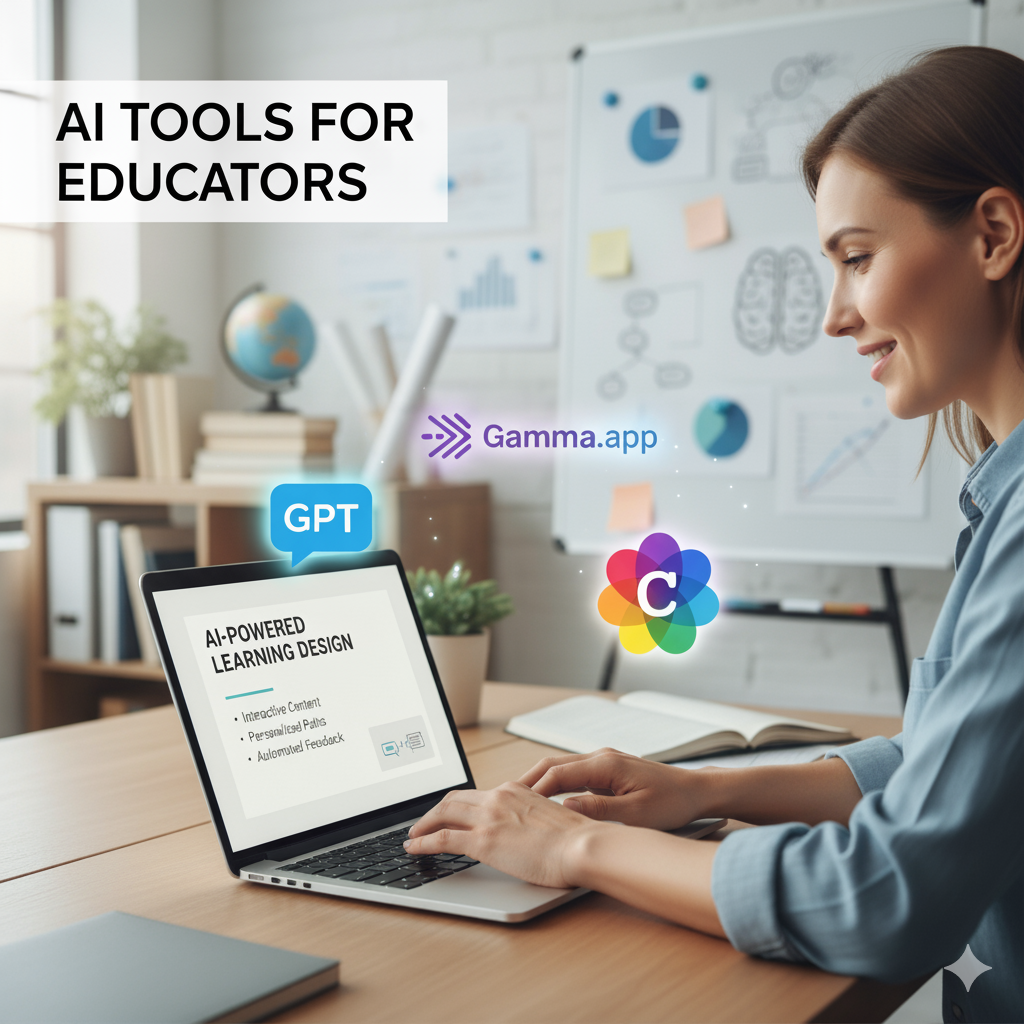Creating standout presentations doesn’t have to take forever. In this article, I share my personal creative journey and AI presentation workflow for creating visually striking slides using ChatGPT, Gamma, and Canva. Perfect for training sessions, workshops, or classrooms, this approach shows how to blend speed, creativity, and control, making every presentation truly yours.
Table of Contents
When Efficiency Meets Ownership
Some time ago, in a professional community of practice for learning designers, someone dropped a comment that caught my attention:
“I love Gamma.app, creates really pretty presentations especially when you don’t have too much time. But I’ve come to realize that the presentations I used to spend hours on were thoughtfully and intentionally created to visually support my sessions. I’m seeing my colleagues go through this too. The output is getting quite generic.”
It wasn’t a long discussion, just a few short reactions. But that single comment got me thinking deeply about the balance between speed and originality. AI tools like Gamma make our design work faster and visually appealing, yet something seems to get lost along the way; that personal touch, that creative ownership.
I began reflecting on my own experience and how I had gradually moved from manual design to a more AI-assisted workflow.
From Scratch to Smart: My Journey into AI Tools
Before AI tools became mainstream, I used to design all my presentation slides from scratch in Microsoft PowerPoint. And honestly, I enjoyed it. Every element from image, icon, or text box had meaning. My slides were usually visual, simple, and intentional, designed to guide my sessions rather than fill them with words – the final deck was fully mine!
But the truth? It took forever. I could spend over six hours crafting a single presentation. The process was satisfying, yes, but tiring.
Then came Canva. It was a relief! I could start from beautiful templates, tweak designs, and save some time. But even then, I wasn’t fully satisfied.
Then I discovered Gamma.app. My first presentation was ready in less than five minutes. It was beautiful; sleek, polished, and professional. But when I looked closer, it didn’t quite capture my message the way I intended. I had a feeling similar to that expressed by my colleague in the story I shared earlier.
That’s when a thought hit me: What if I didn’t have to choose between speed and ownership?
That was how my three-stage AI workflow came to life:
🧠 ChatGPT + 🎨 Gamma + 🧩 Canva.
Why Every Educator Should Care
Educators spend hours designing lesson slides, training decks, and workshop materials. These slides often set the tone for our sessions. The rise of AI tools has offered us a chance to focus less on design frustration and more on purposeful communication.

Below is my three-stage AI presentation workflow:
Stage 1: ChatGPT — The Thinking Partner
I start here. I outline the project, audience, and goals. I let ChatGPT help me create an outline, complete with visual & design ideas. Then I ask it to generate slide-by-slide prompts for Gamma. I refine these and ensure the structure of the slides.
Stage 2: Gamma — The Quick Designer
Next, I will paste the ChatGPT-generated prompts into Gamma. I usually will choose Traditional 16:9, not Fluid, so the final result comes in a form I can easily export to PowerPoint. Gamma gives me a complete deck, looking visually appealing and with great layouts, all in a few minutes.
Stage 3: Canva — The Final Polish
Finally and to make the design truly mine, I import my deck from Gamma into Canva for full editing, font changes, colour alignment, and personal branding. I will typically replace the “Made by Gamma” tag with my own branding elements. In Canva, I can change things around, replace images and ensure consistency across all slides.
Let me note that the free Gamma app let’s you create only 10 slides, so I select the main content slides, removing all intro, thank you and assessment slides. I’ll add all of that back in Canva!
⌛ Time saved: 5–6 hours before AI → about 1 hour now.
Beyond Speed: The Power of Intention
Working faster is good, but working better is even more important. AI should not just save time; it should enhance quality. The more thoughtful your prompts are, the better the results.
AI has blurred many lines between original and generated work. But as educators, we must remember that our ideas must still be ours.
Taking ownership means you remain the author; AI is your assistant.
A Final Thought
AI has truly changed how I design and prepare for my sessions, but it hasn’t changed why I do it. Every slide must still communicate meaning, support learning, and reflect my voice as an educator.
“Whether I spend one hour or six, the goal is the same; to create something purposeful, engaging, and uniquely mine.”
In my next post, I’ll take you behind the scenes of my three-stage workflow, step by step, showing exactly how I use ChatGPT, Gamma, and Canva together, complete with prompts and results, to create a professional deck in under an hour.
So let’s talk, how do you currently design your presentations? Have you found a way to blend your creativity with AI tools like Gamma, ChatGPT, or Canva? What other tools do you use? Share your process in the comments; we learn better together.


Great post, thanks Dr Daniel.
The contents are timely and of high value to me.
Shalom.
Thank you Mr Olumide for your comments, I am glad you found value in it.
All the best,
#DA